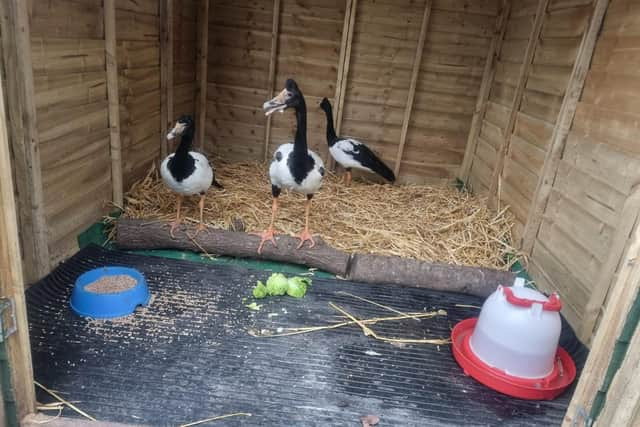OAP geese get a cold weather chalet stay at Arundel Wetland Centre
and live on Freeview channel 276
Twenty-one year old male Basil, and two females - the twenty year old Rosemary and thirty year old Thyme are magpie geese, a species from New Zealand. They rule over a family group of six geese. As befits their rank and age, their private chalet (actually a new garden shed) is packed with lots of straw to keep them cosy each night. Flock patriarch Basil also gets some physio for his arthritic knee each morning from the Keepers at Arundel Wetland Centre. The chalet has been nicknamed “Basil’s Palace” and a wooden address plaque was donated for the entrance gate.
Head Keeper Sam McKinlay said: “Magpie geese can live thirty years so Thyme is doing really well. They are unusual looking geese with a bony crest on their head that makes them look, well - a bit prehistoric.”
Advertisement
Hide AdAdvertisement
Hide AdEach winter the Keepers put out smaller wooden hides lined with straw in all the exhibits to help the more tropical species in the bird collection protect their feet from frost bite. Fresh straw is brought in for all the hides every Monday.


During cold weather many of the ducks and geese at Arundel Wetland Centre find shelter under vegetation to stay protected from bad weather and cold winds. Birds also have two layers of feathers - soft fluffy down on the surface of the skin covered by harder, overlapping contour feathers on top. The two layers of feathers create an air gap in between - this air gap helps birds to stay warm in winter, holding on to the heat and keeping their temperature higher.
The feet of birds and ducks do get cold in winter but their feet are mostly bone and tendons, so few nerves and little fluid. The circulation of blood to their feet is very rapid and is limited to their legs so their bodies stay warm. Birds often stand on one leg, swapping over to warm their feet or sit on their feet to warm them with their own feathers.
WWT Arundel Wetland Centre is open 7 days a week from 10 am until 4.30 pm each day. Search WWT Arundel for more information.